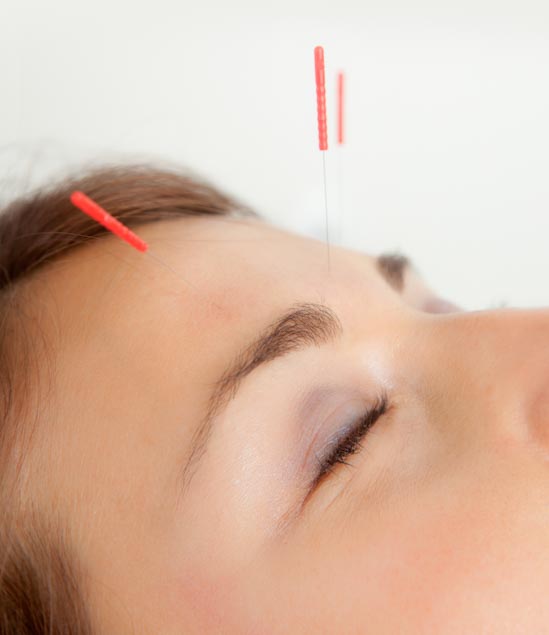Research, including both subjective and objective measurements, finds acupuncture effective for improving eyesight.
Scientific measures show improvements across several key eyesight indices. Visual acuity and light sensitivity demonstrate significant improvements; visual defects reduced significantly. Researchers conclude, “acupuncture treatment contributed to the recovery of the visual function.”
 Insertion of Yintang
Insertion of Yintang
Acupuncture benefits eyesight for patients with vision loss, according to Beijing University of Chinese Medicine researchers. Results from a controlled investigation by Yan et al., published in the Journal of Beijing University of Traditional Chinese Medicine, tested the efficacy of a four point acupuncture prescription for the treatment of vision loss. Based on the data, the researchers determined that acupuncture benefits vision.
Acupuncture measurably caused significant improvements in important visual indices. Acupuncture significantly improved mean sensitivity (MS) and decreased mean defect (MD) for patients participating in the study. In addition, acupuncture significantly increased the visually evoked potential (VEP).
MS is a measurement of the retina’s mean sensitivity to light. MD is the difference between all classes of visual defects for the patient compared with normal values for their age. VEP is an EEG (electroencephalogram) measurement of an evoked potential triggered by a visual stimulus. VEP helps in the detection of optic nerve disorders and tests responses to light. The results of the investigation demonstrate that acupuncture improves MS, MD, and VEP for patients with vision loss.
Three local acupuncture points in the eye region were combined with one acupuncture point in the suboccipital region. All four acupuncture points are classically indicated within Traditional Chinese Medicine (TCM) for the treatment of eye disorders. From an acupuncture continuing education perspective, this modern scientific research draws upon an ancient TCM acupoint prescription for the acupoint selection.

Local acupuncture points in the eye region were not manually stimulated with reinforcing or reducing techniques. No lifting, thrusting, or rotating techniques were applied. The following acupoints were used for all patients in the study in a strict acupuncture point prescription protocol:
- Jingming (BL1)
- Chengqi (ST1)
- Shangming (Ex-HN)
- Fengchi (GB20)
GB20 was the only acupoint receiving manual acupuncture stimulation following insertion. Rotating and thrusting techniques for the purposes of tonification were applied to GB20. Total needle retention time for all acupoints was thirty minutes per session. Acupuncture was applied once per day for four weeks. In terms of acceptance within TCM circles, this treatment protocol was employed by Wei Yu Ying, a renowned Chinese ophthalmologist.
The research was conducted under direction of the Department of Ophthalmology at the Dongfang Hospital (Beijing University of Chinese Medicine). Given the significant improvements in mean sensitivity, mean defect, and visually evoked potential, the researchers conclude that acupuncture benefits vision for patients with diminished eyesight.
These findings are consistent with those of Dai et al., whose research produced a meta-analysis of thirteen randomized controlled trials involving 1,180 eyes. Dai et al. conclude that acupuncture is effective for the treatment of optic atrophy, demonstrating improvements in visual acuity, visual field, and P-VEP. Based on the findings, Dai et al. recommend additional investigations to confirm the results.
In related research, Qin et al. conclude that acupuncture benefits vision for patients with NAION (nonarteritic ischemic optic neuropathy). Acupuncture improved both visual acuity and light sensitivity and also reduced visual field defects. Dai et al. note, “regular and continuous acupuncture treatment contributed to the recovery of the visual function of these patients. . . . acupuncture repaired and reconstructed the visual pathways.”
References:
Yan XL, Wei QP, Li L, Zhou J. (2014). Curative effect of needling in 3 acupoints around eye and Fengchi (GB20) on optic atrophy. Journal of Beijing University of Traditional Chinese Medicine. 37(6).
Dai, Yanli, Ming Liu, Yixin Zhang, Shihui Wei, and Houbin Huang. "[Meta analysis of acupuncture in the treatment of optic atrophy]." Zhong nan da xue xue bao. Yi xue ban= Journal of Central South University. Medical sciences 38, no. 3 (2013): 283-290.
Qin, Yali, Wei Yuan, Hui Deng, Zhanmei Xiang, Chao Yang, Xinyun Kou, Shufei Yang, Zhijun Wang, and Ming Jin. "Clinical efficacy observation of acupuncture treatment for nonarteritic anterior ischemic optic neuropathy."

